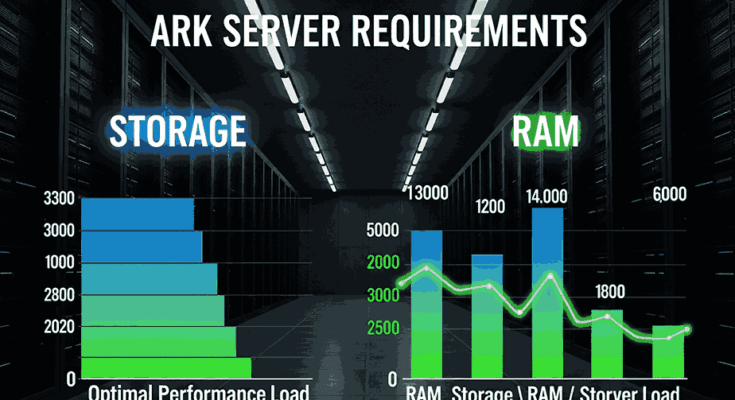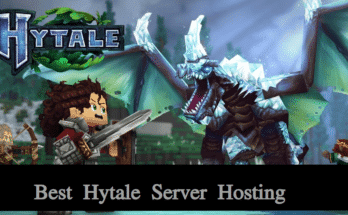Thinking about hosting your own ARK: Survival Evolved server? Whether you’re building a private world for a few friends or starting a larger multiplayer community, understanding the right ARK server requirements is the first and most important step. ARK isn’t just another survival game; it’s a demanding title filled with dinosaurs, massive environments, and intense player action. Hosting a server for it takes more than just enthusiasm; it takes the right hardware.
Unlike lightweight games, ARK requires strong CPU performance, plenty of RAM, and fast storage. This is especially true if you use mods or have more than a few players online at once. If your server lags, crashes when the player count goes up, or struggles to save progress, the problem is likely your hardware, not your internet.
💡 Looking for an easier way to host ARK: Survival Evolved? We recommend Apex Hosting—a top-tier provider trusted by thousands of ARK players. With lightning-fast NVMe SSDs, powerful high-clock CPUs, and global server locations, Apex takes care of performance, uptime, and support—so you can focus on taming dinosaurs, building your base, and surviving the island.
Table of Contents
✅ Quick Answer: What Are the ARK Server Requirements?
To host an ARK: Survival Evolved server, you’ll need a CPU with strong single-core performance, at least 8–16 GB of RAM, and fast SSD storage. Bandwidth also matters; upload speeds of 10 Mbps or more are ideal for multiplayer sessions. The requirements increase significantly when using mods, large maps, or hosting 20+ players. For best results, use a dedicated server or cloud host with modern hardware.
👉 Best ARK Server Hosting Providers in 2025
CPU Requirements for ARK Servers
When it comes to hosting ARK: Survival Evolved, CPU performance is king. Unlike many other multiplayer games that distribute workloads efficiently across multiple cores, ARK relies heavily on strong single-core performance. This means that the clock speed and per-core performance of your processor often matter more than how many cores you have, especially for small to mid-sized servers.
Why ARK Is CPU-Intensive?
ARK servers must constantly process AI for creatures, player interactions, physics, weather changes, and base structures—all in real time. The larger the world or the more players and tamed dinos you have, the more CPU power your server will consume. Mods and total conversion packs like Primal Fear or Genesis 2 can push CPU usage even higher.
Minimum vs Recommended CPUs
Here’s a rough breakdown of what CPU power you’ll need based on player count:
| Player Count | Minimum CPU (Base Clock) | Recommended CPU (High Clock) | Example CPUs |
|---|---|---|---|
| 1–10 players | Dual-core @ 3.0 GHz | Quad-core @ 3.5+ GHz | Intel i5-8600K, AMD Ryzen 5 3600 |
| 10–30 players | Quad-core @ 3.2 GHz | 6-core @ 3.7+ GHz | Intel i7-9700K, AMD Ryzen 7 5800X |
| 30+ players | 6-core @ 3.5 GHz | 8-core @ 4.0+ GHz | Intel i9-12900K, AMD Ryzen 9 5900X |
💡 Tip: It’s better to go for fewer, faster cores than many slower ones unless you plan to host multiple game servers on the same machine.
Dedicated vs Shared Hosting CPUs
If you’re renting a server, make sure your hosting provider offers dedicated CPU threads, not shared virtual cores. Shared environments (like on cheap VPS plans) often throttle performance during peak hours, leading to lag spikes in-game.
In summary, for a smooth ARK experience:
High clock speed (3.5 GHz and above) is more important than total core count.
Avoid older CPUs with weak per-thread performance.
Always leave headroom if you plan to add mods or increase player count.
RAM Requirements for ARK Servers
If the CPU is the brain of your ARK server, then RAM is its short-term memory—and trust us, ARK has a lot to remember.
Every player, creature, structure, and mod asset loaded into the world consumes memory. Unlike many lightweight survival games, ARK doesn’t just load a small portion of the map. Instead, it often loads massive world data, including assets from mods, DLC maps, and player-built bases, all of which require generous amounts of RAM to avoid lag or crashes.
How Much RAM Do You Really Need?
The amount of RAM your server needs depends on the number of players, the number of mods, and the map you’re running (for example, Genesis and Ragnarok are more demanding than The Island).
Here’s a general RAM usage breakdown:
| Player Count | Base Game (No Mods) | With Mods (10–15) | Heavy Modded Maps (Primal Fear, etc.) |
|---|---|---|---|
| 1–10 players | 6–8 GB | 10–12 GB | 12–16 GB |
| 10–30 players | 10–12 GB | 14–18 GB | 18–24 GB |
| 30+ players | 16+ GB | 24–32 GB | 32–64 GB |
💡 Tip: Always add extra headroom (at least 2–4 GB) beyond the estimated requirement to avoid crashes during backup, saves, or map transitions.
RAM Optimization Tips
Unload unused mods: Every mod, even inactive ones, can increase memory use.
Limit structure spam: Too many player-built objects (walls, foundations) can eat memory.
Restart your server daily: This clears memory leaks and keeps performance stable.
Should You Use Swap Space?
No. Swap (virtual memory on disk) is not a replacement for physical RAM, especially for a game like ARK. Relying on swap will lead to severe lag, stuttering, and even server timeouts.
In short:
Go big on RAM if you’re using mods.
More players = more memory needed.
Don’t cheap out—ARK eats RAM for breakfast.
Storage Requirements for ARK Servers
Storage often gets overlooked when setting up an ARK server, but it plays a critical role in performance, especially when it comes to loading times, autosaves, and mod management. ARK’s massive game files and frequent read/write operations demand fast and reliable storage.
Base Game and Expansion Sizes
The base ARK: Survival Evolved server files already take up a considerable amount of space, and when you start adding maps and mods, the footprint grows quickly.
Here’s a breakdown of average storage usage:
| Component | Approx. Size |
|---|---|
| Base game (The Island) | ~20 GB |
| DLC maps (Ragnarok, etc.) | +5–15 GB per map |
| 10–15 mods | ~5–10 GB |
| Save files & backups | ~1–5 GB (varies) |
📁 Total Estimated Size: 40–60 GB for a moderately modded server
SSD vs HDD: Which One to Choose?
SSD (Solid State Drive):
✔️ Faster map load times
✔️ Quicker backups and saves
✔️ Smoother gameplay experience
✔️ Highly recommended for modded servers
❗ Slightly more expensive per GBHDD (Hard Disk Drive):
❌ Slower performance
❌ Can cause lag when saving or loading large maps
✔️ Cheaper for bulk storage (not ideal for live hosting)
💡 Tip: Use an SSD for hosting the live server, and optionally use an HDD for storing old backups.
Backup and Storage Best Practices
Enable auto-backups to avoid losing progress after crashes or updates.
Store backups offsite or in cloud storage if you’re running a public or community server.
Clear out old mods and maps you no longer use to free up disk space.
In summary:
Use SSDs for optimal performance.
Plan for at least 60 GB of free space for most scenarios.
Keep extra space for future maps, mods, and backups.
Bandwidth and Network Speed Requirements
When you’re running an ARK: Survival Evolved server, internet bandwidth and network stability are just as important as CPU and RAM, especially if you’re hosting for players outside your local network.
Unlike some lighter games, ARK transfers a lot of data between the server and connected clients. This includes real-time creature movement, base structure updates, inventory syncing, mod data, and voice chat (if enabled).
Recommended Network Speeds
Below is a general guideline for upload/download speeds based on the number of concurrent players:
| Player Count | Minimum Upload Speed | Recommended Upload Speed | Download Speed |
|---|---|---|---|
| 1–10 players | 5 Mbps | 10+ Mbps | 10 Mbps+ |
| 10–30 players | 10 Mbps | 20+ Mbps | 20 Mbps+ |
| 30+ players | 20 Mbps | 50+ Mbps | 50 Mbps+ |
📶 Upload speed is more important than download speed when you’re the host. All client data flows out of your server.
Local Hosting vs Data Center Hosting
Local Hosting (Home ISP)
❌ Often comes with limited upload speeds and high latency
❌ Risk of ISP throttling or dynamic IP issues
✔️ Good for testing or small private sessionsDedicated Server or VPS Hosting
✔️ Comes with high-speed symmetrical bandwidth
✔️ Lower latency and better uptime
✔️ More stable for long-term or community servers
Tips to Improve Network Performance
Use a wired Ethernet connection (avoid Wi-Fi for hosting)
Forward necessary ports (default ARK ports:
7777,27015,27020)Limit simultaneous downloads/uploads on your network
Monitor for packet loss or jitter using tools like
ping,mtr, oriperf3
ARK Server Requirements at a Glance
To help you quickly compare what kind of hardware you’ll need for different types of ARK servers, here’s a summary table that breaks down minimum vs recommended specs based on the number of players and usage scenario.
| Requirement | Solo/Local (1–5 players) | Small Server (6–15 players) | Medium Server (16–30 players) | Large/Modded Server (30+ players) |
|---|---|---|---|---|
| CPU | Dual-core @ 3.0 GHz | Quad-core @ 3.5 GHz | 6-core @ 3.7 GHz | 8-core+ @ 4.0 GHz+ |
| RAM | 8 GB | 12–16 GB | 18–24 GB | 32–64 GB |
| Storage | 30–40 GB SSD | 50 GB SSD | 60–80 GB SSD | 100+ GB SSD (NVMe preferred) |
| Upload Speed | 5 Mbps | 10–20 Mbps | 20–30 Mbps | 50+ Mbps |
| Connection | Local or LAN | Home with Port Forwarding | VPS/Dedicated Hosting | Dedicated or Cloud Hosting |
| Mods | Light or none | Light to moderate | Moderate to heavy | Heavy + Total Conversion Mods |
✅ Tip: These numbers are starting points. Always monitor your server’s resource usage and scale as your player base and mod list grow.
This table should help you quickly assess your hosting setup or plan your next upgrade based on how many players you expect and how heavily you plan to mod your game.
Pro Tips for Optimizing ARK Server Performance
Even with the right hardware, ARK servers can still lag or crash if they’re not properly optimized. Fortunately, there are several techniques you can use to squeeze more performance out of your server and provide a smoother experience for your players.
1. Use Server Launch Parameters
Custom launch flags can help reduce overhead and control resource usage. Some useful options include:
-NoBattlEye: Disables BattlEye anti-cheat (if you’re playing privately)-UseAllAvailableCores: Enables multi-core support-servergamelog: Logs gameplay events for better tracking
💡 Add these to your
start_server.bator Linux launch script for better performance tuning.
2. Limit Mods and Total Conversion Packs
Mods are great, but they can dramatically increase memory usage and startup time.
Remove unused mods from the mod folder
Avoid stacking heavy total conversion mods unless you have ample CPU and RAM
3. Restart Your Server Daily
ARK has memory leak issues, especially on modded servers. A scheduled restart helps:
Clear memory
Reset stuck processes
Apply updates cleanly
✅ Use a tool like Cron (Linux) or Task Scheduler (Windows) to automate this.
4. Monitor Your Resource Usage
Keep an eye on:
CPU usage spikes
RAM consumption over time
Disk I/O rates
Network throughput
Use tools like htop, glances, or Windows Resource Monitor. This helps you anticipate bottlenecks before they impact gameplay.
5. Optimize Structure Decay and Dino Spawning
ARK’s world can get cluttered over time. Enabling structure decay and tweaking dino spawn rates reduces:
Simulation load on the CPU
Memory used by idle or orphaned entities
6. Run the Server on a Clean OS
Avoid installing unnecessary services or desktop environments on your server OS. The fewer background tasks, the more resources ARK can use.
Conclusion: Choose the Right Hardware for Long-Term Stability
Hosting your own ARK: Survival Evolved server is incredibly rewarding, but only when the experience is smooth, stable, and lag-free. Whether you’re planning a casual LAN session with friends or building a thriving online ARK community, your hardware choices matter.
From high single-core CPU performance to generous RAM and fast SSD storage, every component plays a role in how your server runs. Add to that the network bandwidth needed to support real-time multiplayer action, and it’s easy to see why so many underpowered servers struggle.
The good news? Now you know what it takes.
✅ Use fast CPUs with strong per-core performance
✅ Allocate enough RAM for mods and map expansions
✅ Prioritize SSDs for faster world loading
✅ Ensure stable upload bandwidth for multiplayer sessions
✅ Plan for scaling as your server or community grows
So whether you’re upgrading your current server or building one from scratch, make informed decisions based on your player count, mod usage, and performance goals. The better your foundation, the more epic your ARK adventures will be.
FAQs About ARK Server Requirements
1. Can I run an ARK server on my home PC?
Yes, you can, especially for small groups (1–5 players). Just make sure your PC has at least a quad-core CPU, 8–16 GB of RAM, and an SSD. However, if your internet upload speed is low or you're planning to host for many players, consider a dedicated server.
2. Do I need a GPU to run an ARK dedicated server?
No. ARK dedicated servers run in headless (non-GPU) mode, so a GPU isn’t required. All rendering is handled by the clients (players), not the server. Focus on strong CPU and RAM instead.
3. How much RAM do I need for 20 players with mods?
For 20 players using 10–15 mods, you’ll need at least 16–24 GB of RAM. Heavy mod packs or total conversion mods (like Primal Fear) may require even more—up to 32 GB.
4. Should I rent or self-host my ARK server?
Self-hosting is fine for private or LAN play, but for 24/7 uptime, low latency, and automated backups, renting from a dedicated ARK hosting provider is usually the better choice, especially as your player base grows.
5. What are the ARK dedicated server requirements?
To host an ARK dedicated server, you'll need a CPU with strong single-core performance (3.5 GHz+), 16–32 GB of RAM, and at least 60–100 GB of SSD storage. Heavily modded servers or 30+ players may require even more resources.




